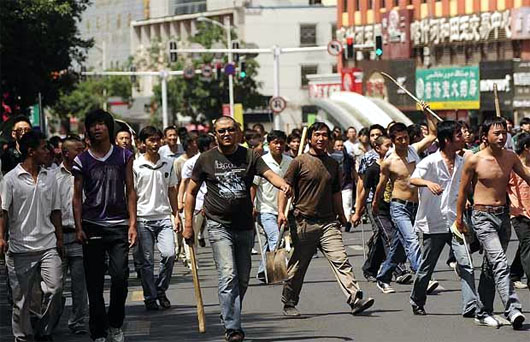Special to WorldTribune.com
China has launched an aggressive defense of its policies in the far western territory of Xinjiang, home to about 12 million various Muslim minorities. An estimated 1 million Muslims are being held at “counterextremism centers” and millions more have been forced into “reeducation camps”.
Uyghurs, a Central Asian Turkic race, are the largest indigenous community in Xinjiang, followed by Kazakhs, another central Asian Turkic people. The region is also home to ethnic Kyrgyz, still another Turkic people, and Hui [Chinese Han ethnic Muslims, also known as Dungans].

More than a million Chinese civilians [most members of the Han ethnic majority] aid the military and police are waging an occupation of the region’s Uyghurs and other Muslim minorities, introducing indoctrination and surveillance. They also present themselves as older siblings of the men and women they might then decide to consign to concentration camps.
Millions of Uyghurs are being forced to give up their cultural beliefs, abandon their ancestral language and switch to Han Chinese names and diets. With China’s majority group migrating to Xinjiang in large numbers over decades, the region’s capital Urumqi is now a non-Muslim Han-ethnic dominated city.
Meanwhile, Chinese government discrimination against the Hui has developed as part of a new campaign against Christians and other religious groups. The 10 million Hui are racially Han Chinese but ethnic Muslims. They are concentrated in China’s northwest but also are notable for their networks of eatery and other entrepreneurial activities in southwest and throughout China.
Beijing’ attempt to wrest back control of the narrative over Xinjiang meets growing international pressure to explain what is happening to the Uyghur minority there. In early October, for example, members of the U.S. Congress including Sen. Marco Rubio said they would nominate a prominent Uyghur intellectual Ilham Tohti, who has been in prison since 2014, for the Nobel Peace Prize. And in August reports criticizing China’s treatment of Uyghurs came up for discussion before a UN rights panel.
Beijing has reinstated use of the term “humane management and care”, avoiding using “education”. It is a term that harkens back to China’s use of education through labor, a system started in the 1950s and abolished in 2013, after being declared incompatible with China’s commitment to rule by law.
Reports have emanated from Singkiang of Muslim confinement in a growing network of razor-wire-ringed camps that China dubs “transformation through education centers”, “counter-extremism training centers” and, more recently, amid international criticism, “vocational training centers.” After months of denying the existence of these camps, officials appear to be trying “normalize” them as “free vocational training” that are more similar to summer camps than de facto prisons where people can be kept indefinitely without due process.
The tyranny in Northwest China pits groups of Chinese citizens against each other in a process that seeks to dominate every aspect of life. It calls Han “relatives” into coercive relations with their Uighur and Kazakh hosts, producing an epidemic of individualized isolation and loneliness as families, friends, and communities are pulled apart. As new levels of unfreedom are introduced, the project produces new standards of what counts as normal and banal.
Han civilians who resist state policies toward Uighurs put themselves in serious danger. Given the totalitarian politics of the Xinjiang police state, Han civilians in Xinjiang often appear to feel as though they have no choice but to participate in the state-directed oppression of Muslim minorities.
A BBC investigation using satellite images from Google Earth and aerospace company GMV has found evidence of a rapidly expanding web of detention facilities. Extensive construction activities can be traced across Xinjiang that point to the remarkable speed at which officials are building the physical infrastructure to hold Muslims without trial.
Sol W. Sanders, ([email protected]), is a contributing editor for WorldTribune.com and Geostrategy-Direct.com.

